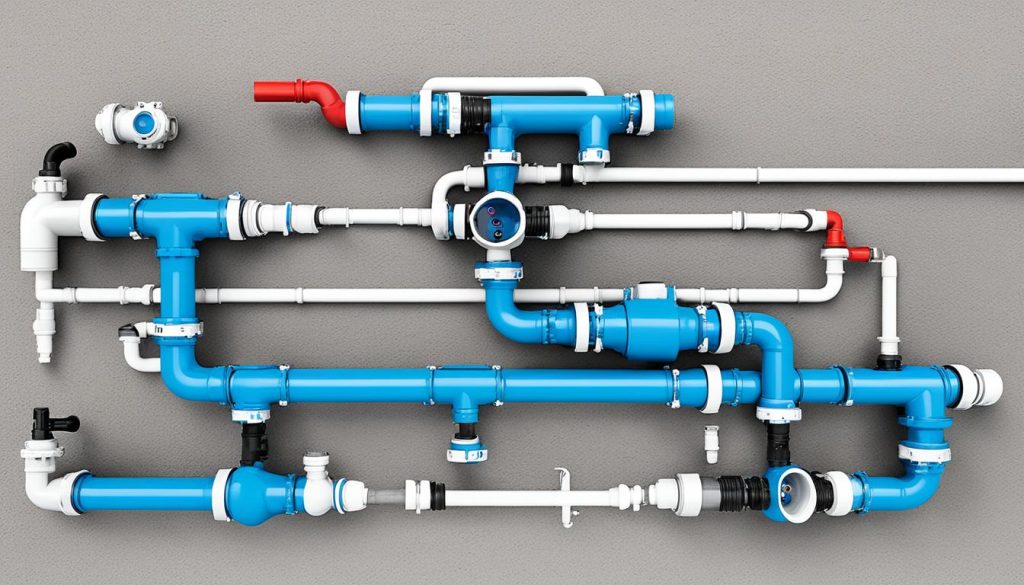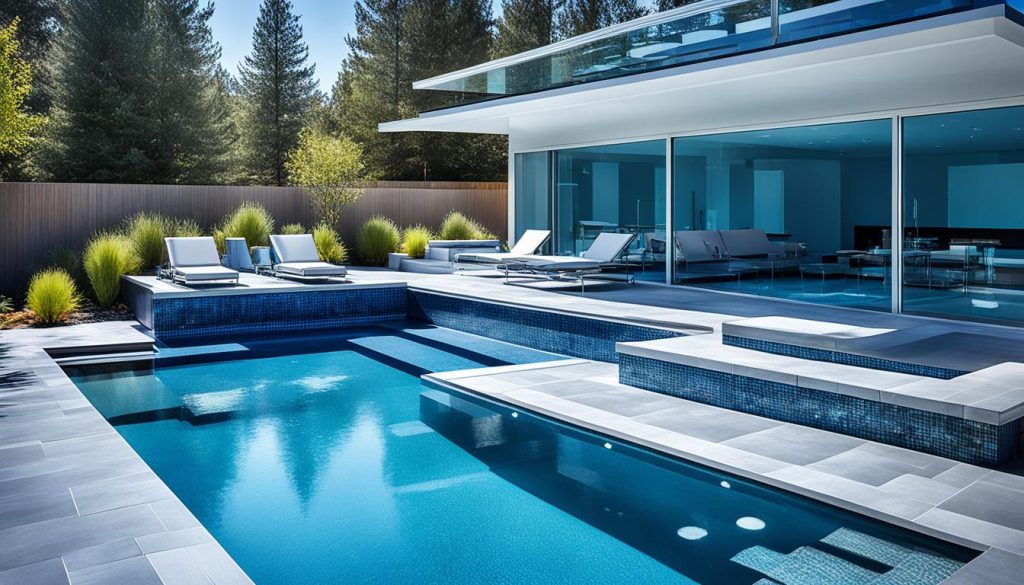Efficient Pool Plumbing Solutions & Tips
Did you know that choosing a variable speed pump over a single speed pump for your swimming pool can result in significant energy cost savings? It’s just one of the many decisions that can impact the efficiency of your pool plumbing system. Whether you’re designing, building, or maintaining a pool, making the right choices can make a huge difference.
Key Takeaways:
- Opting for a variable speed pump can lead to substantial energy cost savings for your pool.
- Proper pipe sizing and design are crucial for efficient pool filtration.
- Laminar flow in pool plumbing systems can significantly increase the maximum flow rate.
- PVC pipes are commonly used for their durability and resistance to corrosion.
- Regular inspections and maintenance play a vital role in optimizing water flow.
The Importance of Pipe Size for Efficient Pool Filtration
The size of the plumbing pipes used in a swimming pool plays a crucial role in determining the efficiency of pool filtration. Proper pipe sizing is essential to achieve optimal flow rates and ensure a consistently clean and well-maintained pool. When the pipe size is mismatched or inadequate, it can lead to friction, turbulence, and increased resistance, resulting in inefficient water flow.
Fast-moving water in undersized pipes experiences higher levels of friction, which can hamper filtration efficiency and put strain on the pool’s plumbing system. On the other hand, slow-moving water with laminar flow, characterized by smooth and streamlined movement, offers highly efficient filtration with minimal friction or resistance.
To achieve efficient pool filtration, it is crucial to determine the right pipe size based on the flow rate requirements. A properly sized pipe will optimize the movement of water through the pool plumbing system and maximize the effectiveness of the filtration process.
An Example Calculation
Let’s consider an example to better understand the importance of pipe size for efficient pool filtration. Suppose we need to achieve a flow rate of 50 gallons per minute (GPM) for effective filtration. By consulting industry standards and recommendations, we find that a pipe size of 2 inches can accommodate this flow rate efficiently.
However, it’s important to note that oversizing the plumbing system may increase the maximum flow rate but may not always be cost-effective or necessary. Considering safety ratings and equipment limitations is essential when designing and sizing the pool plumbing system.
In summary, attaining efficient pool filtration relies on proper pipe sizing to ensure smooth and laminar flow. By choosing the right pipe size, pool owners can optimize their pool’s system efficiency, improve water circulation, and maintain a clean and enjoyable swimming environment.
Understanding the Key Components of Pool Plumbing
Pool plumbing consists of several key components that work together to ensure proper water circulation and filtration. Each component plays a crucial role in maintaining a clean and well-functioning pool. Let’s take a closer look at these essential pool plumbing components:
1. Pool Skimmer
The pool skimmer acts as a dedicated cleanup crew, intercepting debris before it reaches the main circulation system. It is typically installed on the side of the pool, parallel to the waterline. As water flows into the skimmer, it creates a skimming action that pulls in leaves, bugs, and other floating debris. This helps to keep the pool water clean and free from larger impurities.
2. Pool Pump
The pool pump is the heart of the plumbing system, responsible for circulating water through the filtration system and back into the pool. It creates suction, pulling water from the pool and sending it through the filtration system to remove impurities. The pool pump plays a vital role in maintaining water quality and preventing stagnation.
3. Suction Lines
Suction lines draw water from the pool and deliver it to the pool pump and filtration system. These lines are typically connected to the main drain and skimmer, ensuring a continuous flow of water for proper circulation and filtration. Suction lines should be free from obstructions to maintain optimal water flow.
4. Pool Filter
The pool filter is responsible for removing impurities from the water. It traps debris, small particles, and contaminants, ensuring that the water remains clean and clear. There are different types of pool filters available, including sand filters, cartridge filters, and diatomaceous earth (DE) filters. Regular maintenance and cleaning are essential to keep the filter functioning effectively.
5. Return Lines
Return lines distribute clean, treated water back into the pool. After passing through the filtration system, the water is returned to the pool through these lines. Return lines are typically fitted with return jets or nozzles, which help to create water circulation and even distribution throughout the pool.
6. Main Drain
The main drain is an essential component that helps with water circulation and ensures proper mixing of chemicals. It is typically located at the deepest point of the pool and provides an outlet for water to be drawn into the filtration system. The main drain also serves as a safety feature, preventing suction entrapment.
7. Water Level
Maintaining the appropriate water level is crucial for the optimal operation of the pool plumbing system. The water level should be maintained within the recommended range to ensure proper skimming, filtration, and water circulation. Regular monitoring and adjustment of the water level are necessary to maintain the efficiency of the pool plumbing components.
| Pool Plumbing Component | Function |
|---|---|
| Pool Skimmer | Intercepts debris before reaching the main circulation system |
| Pool Pump | Circulates water through the filtration system |
| Suction Lines | Draws water from the pool and sends it to the filtration system |
| Pool Filter | Removes impurities from the water |
| Return Lines | Distributes clean, treated water back into the pool |
| Main Drain | Assists with water circulation and chemical mixing |
| Water Level | Ensures optimal operation of the pool plumbing system |
Common Issues Affecting Pool Water Flow
When it comes to maintaining a pool, ensuring proper water flow is essential for optimal performance. However, there are common issues that can affect the water flow in your pool. Understanding these issues and taking proactive measures can help you prevent and address any problems that arise.
Clogged Mechanisms
One of the main culprits behind low water pressure in a pool is clogged mechanisms. Skimmer baskets, strainer baskets, filters, and impellers can become clogged with debris over time, restricting the water flow. Regular inspections and cleaning of these components are crucial for maintaining optimal water flow in your pool.
Plumbing Problems
Another factor that can lead to decreased water flow is plumbing problems. Burst or collapsed pipes can disrupt the flow of water, causing low water pressure in your pool. It is important to regularly inspect your plumbing system for any signs of damage and address any issues promptly to ensure proper water flow.
Pool Features
If you have multiple pool features, such as waterfalls, fountains, or additional jets, using them simultaneously can strain the pool system and result in reduced water flow. It is important to consider the capacity of your pool’s plumbing system and avoid overloading it with too many features running simultaneously.
Water Flow Optimization
To optimize the water flow in your pool, there are several steps you can take. Regularly inspecting the pool components, cleaning debris from skimmer baskets and filters, and monitoring the performance of the plumbing system can help identify and address any issues affecting water flow. Additionally, seeking professional assistance for significant problems or when unsure about maintenance tasks can ensure proper water flow and prevent further damage to your pool.
Tips for Improving Pool Water Flow
Regular inspections play a crucial role in maintaining optimal water flow in your pool. By regularly inspecting pipes, filters, and pressure gauges, you can identify any issues that may be affecting water circulation. This proactive approach allows you to catch problems early on and address them before they become major headaches.
Debris clearance is another important aspect of improving water flow. Clearing out debris from skimmer baskets, strainer baskets, and filters is essential for maintaining optimal water pressure. Removing leaves, twigs, and other debris that can clog the system ensures that water can flow freely and prevents any restrictions in the plumbing.
Regular pool component maintenance is key to preventing restrictions in water circulation. By taking care of pool components such as pumps and heaters, you can avoid potential issues that may impede water flow. Regular servicing, cleaning, and lubricating can help keep your pool system running smoothly and efficiently.
While regular maintenance and inspections can address many issues, there may be cases where professional assistance is needed. For significant problems or when unsure about maintenance tasks, seeking the help of a professional can save you time, money, and potential frustration. A pool plumbing expert can diagnose and resolve any complex issues, ensuring optimal water flow and system performance.
To optimize the pool water level and protect the plumbing system, it is important to avoid complete draining of the pool. Draining the pool can lead to potential problems such as pipe collapses and challenges in reestablishing the optimal water level. By maintaining the appropriate water level, you can ensure the efficient operation and longevity of your pool plumbing system.
- Investing Wisely: How Windows & Doors in Boost Property Value and Financial Health - April 24, 2025
- The Financial Impact of Personal Injuries: Why Legal Help Matters for Business Owners - April 16, 2025
- The Hidden Financial Costs of Domestic Assault: What Business Owners Need to Know - April 16, 2025













